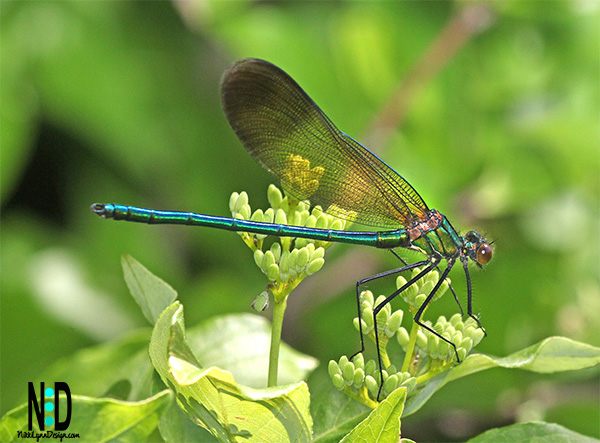Broad-winged Damselflies
The four broad-winged damselflies (Calopterygidae) are found in Wisconsin.
3 Groups In The Damsel Family
Damselflies are categorized into three groups the spreadwing damselflies, pond damselflies, and the broad-winged damselflies.
Broad-winged Damselflies

In the United States, there are eight species in the damsel family.
This page features the four species in the broad-winged damselfly family that visit Wisconsin
Most species fold the wings along the body when at rest, unlike dragonflies which hold the wings flat and away from the body.
Reproduction
The damselflies remarkably lay their eggs. These insects have well-developed ovipositors with which they can make incisions in the stems or leaves of plants. Some of the species at least, when they wish to lay their eggs, crawl down the stems of aquatic plants and lay their eggs in them beneath the water.
The nymphs of damselflies are truly aquatic, having gill-like organs that enable them to live in water without coming to the surface from time to time for a supply of air. They may be found in those ponds or streams about which the adults fly, and are most abundant among the stems of submerged plants.
4 Broad-winged Damselflies

River Jewelwing
The River Jewelwing (Calopteryx aequabilis) iis one of the broad-winged damselflies and s found during the months of June and July. This jewelwing is metallic green with dark black webbing coloring throughout its clear wings.

Ebony Jewelwing
Ebony Jewelwing (Calopteryx maculata) is commonly found near bodies of water. The jeweling is found at rest and in-flight the last week of May into the first week of the month of August.
Males and females have a similar green metallic appearance and glossy black wings. The difference between the males and females is females have white pseudostigma spots on their wings.

American Rubyspot
American Rubyspot (Hetaerina americana) fly from June through the first week of September.
Take notice of its bright red upper body, striking red eyes, and black webbing in the clear wings. The tail of the damselfly has prominent striping in a black and tan pattern.
Smoky Rubyspot
Smoky Rubyspot (Hetaerina titia) is common in the Southern United States. The damsel is found a few times in the Southern half of Wisconsin, along the Illinois border.
Rubyspots will be active during August and in addition through September.
Besides the broad-winged damselflies, there are another two families of damsels including the spreadwing which has 11, and the pond species which has 34.
Sharing Is Caring. Pin Me.

Explore More
AFFILIATE POLICY: Posts on this site may contain links to outside vendors that pay me a commission at no additional cost to you. Thank you for supporting this site!



